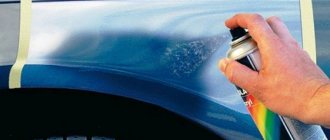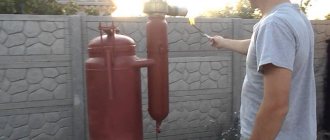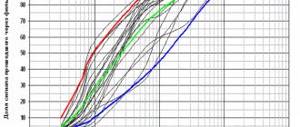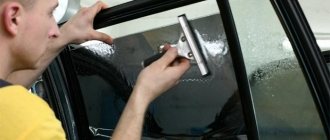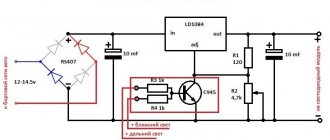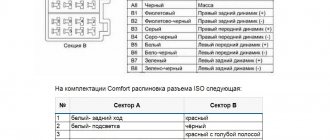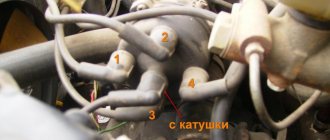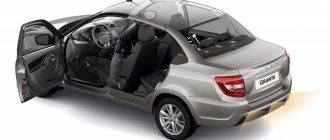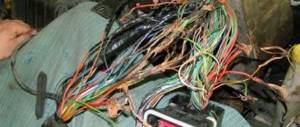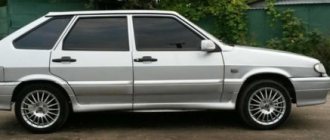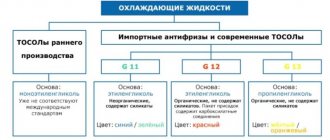Torsional rigidity indicator
Torsional rigidity of the body or LC/c is a value that characterizes the strength characteristics of the automobile frame, its durability and safety. This value has a strong influence on the car’s handling. That is why the world's famous supercars, equipped with carbon fiber and soft lightweight body panels, are distinguished by the highest values of this very parameter. Let's look at the LCD performance of well-known domestic models and compare them with the performance of foreign cars.
Indicators of the Lada Kalina model
Kalina's car frame is designed taking into account the most important safety regulations. Approximately twelve percent of the body elements on this domestic car are made of high-strength steel. More than half of the iron is coated with zinc. For comparison, for example, on the popular “ten” only 33 percent of the iron was galvanized.
Strength characteristics of the Kalina body
As for LCD/c, Kalina’s indicator is a full twenty percent higher than that of the same “ten”. The PB of the Lada Kalina sedan, even without the use of airbags, has 3 stars out of 5 according to the Euro crash test system.
Despite the large amount of criticism against Kalina, designers and engineers of the domestic car plant regularly make improvements. In particular, if you take a closer look at the second generation Kalina, you will see important points.
For example, what is a successful exterior worth - more solid, aggressive and, of course, attractive. All this was achieved with simple techniques: we raised the hood a little, added more chrome trim and improved the appearance of the optics.
Now, as for the management itself. On the old Kalina, as soon as you turned the steering wheel to the right and left, the car began to roll over, although it retained the straightness of movement. It is not known whether anyone dared to experiment with the steering wheel on bad roads, because this threatened almost a “changeover”.
The new Kalina will definitely not give such a reason, since in addition to increasing the LCD value, a clear adjustment of the steering was carried out. As a result, it has become easier to avoid road irregularities, bumps and holes.
Body and its characteristics
Interesting. The following settings helped make the steering sharper. The “short” rack technology mastered on foreign cars was used, and instead of four turns of the steering wheel, only three were left. And another change concerned more rigid fasteners.
Another fact is noteworthy. Previously, the steering wheel was fixed using rubber bushings. The technology is proven, but clearly outdated. And so AvtoVAZ decided to try, however, only on the left rack support a more rigid fastening method. This immediately bore fruit: the stiffness of the steering system increased by as much as 25 percent!
AvtoVAZ engineers did a good job, also adding a new rear suspension compression buffer. The part has advanced characteristics that reduce roll several times. Coupled with the increased indicators of LCD/c, this gives a powerful effect, and Kalina began to resemble Grant more and more with its confident “steering” and uninterrupted operation of the suspension.
Determination of paint thickness by car brands
If the machine has been repaired and putty has been applied to the parts, the thickness of the coating layer will increase to 180-200 microns or more. You need to check such deviations with a special device for measuring paint - a thickness gauge. Such devices allow you to accurately measure the paint layer on products made of metal, plastic, and glass.
Modern thickness gauges do not harm the car's coating or violate its integrity. Inexpensive models help determine only the presence of putty, while higher-end products provide information about even the slightest repainting of the body. The operating principle of any thickness gauge is to calculate the interval from the sensor to the base.
Classification of thickness gauges
You can measure the thickness of paint using different instruments; there are several main ones, which differ in the method of taking measurements.
Electromagnetic thickness gauges
Such devices are only used for measuring paint on metal parts. They will not help in assessing the condition of plastic elements or non-ferrous metal products. Magnetic induction and the Hall effect are used for operation; all calculations are made based on the magnetic field density. This field is created by a soft ferromagnetic rod with a coil. The permissible percentage of error is 3%.
Eddy current thickness gauges
An electric current is generated on the surface of the probe of such a device, which passes through a coil of wound wire. As a result, an alternating magnetic field is created. When the probe is brought closer to a conductive surface (metal), Foucault currents (eddy currents) are formed, with the help of which the necessary data is obtained. Such devices are suitable for parts made of aluminum and other non-ferrous metals. The price of the devices is quite high - about 5 thousand rubles.
Capacitive thickness gauges
These measuring instruments are suitable for conductive non-magnetic products. The sensor itself serves as the first plate of the capacitor, the second will be the body. Between them there is a dielectric - a layer of paint, the capacitance of which will be measured by the device. But such thickness gauges have significant disadvantages - they are very sensitive to moisture, and their contact surface is large.
Ultrasonic thickness gauges
Such thickness gauges work with parts made of any material - metal, plastic, composites, ceramics, glass, so the user will have the opportunity to measure the layer thickness on all main and decorative parts. The probe of the devices contains an ultrasonic sensor that sends pulses through the coating. After the pulse is reflected from the surface, it is transformed into an electrical signal. The result is instantaneous - in a second the necessary numbers will be visible on the screen. The only downside is the very high price (from 10 thousand rubles).
Selection of devices
When choosing a device, it is important to understand what you plan to measure, for what purpose, and how often it will be used. If a thickness gauge is purchased by a professional, it is better to pay attention to ultrasonic models. Additional functions may be important to craftsmen - an extended temperature range, a long operating time without recharging, backlighting, the ability to connect to a computer, and load results into memory.
Those who decide to buy a device for household needs should consider less expensive options. These are electromagnetic and vortex thickness gauges. The quality of measurements will be at a decent level, the user will be able to establish the fact of repair work and the exact details of its implementation.
What else should you consider when purchasing? Here are the additional parameters of the thickness gauges:
- Battery capacity;
- launch by pressing a trigger or button;
- display size.
The most popular brands of devices are ET, CHY Firemate Company, Horstek, PHYNIX.
Lada Priora
The next domestic model produced at the Volzhsky Automobile Plant is the Lada Priora. Today it is produced in 4 body variations. The line of models also includes the Priora Coupe - which, however, has not yet gained any popularity among Russians.
Lada Priora
An important parameter of the Priora body, again, is the LCD/c value. It is noteworthy that for the Priora this figure is 12,000 Nm/deg in the sedan version. In other variations, except for the coupe, it is a row lower.
Despite this, there are general indicators for all 3 models, implying body dimensions. Thus, all body types (except coupe) have the same wheelbase, ground clearance and width. As for the length, let us recall that the sedan’s figures are 4350 mm, the hatchback’s are 4,210 mm, and the station wagon’s are 4,340 mm. The heights of the bodies are also different: the sedan is 1420 mm, the hatchback is 1435 mm, and the station wagon is 1508 mm.
Initially, the weak areas of Priora bodies were considered to be the roof, hood and trunk. It is for this reason that experts insist on the mandatory treatment of all internal surfaces of problem areas by the car owner himself with an anticorrosive agent.
Priora body protection against corrosion is provided for 6 years. In practice, this period is determined by: zinc coating of the sills, bottom and arches, as well as the use of low-alloy steel.
Dimensions of Priora
Indeed, practical experience has proven that the Priora body is incredibly resistant to corrosion. If problems start, the first ones at risk are the bumpers, then bubbles form on the paintwork in the winter, and the paint peels off.
The 12 thousand Nm/deg indicator on the Priora sedan is not a large value. Even the VAZ-21106, not to mention foreign cars, has a higher figure. Thus, Priora owners who prefer active driving would do well to strengthen the car’s frame. In particular, strengthening should involve the installation of strut struts and modernization of the SPU on the rear axle.
How to use a thickness gauge correctly?
When purchasing a car on the secondary market, it is not enough to know how the purchase and sale transaction and vehicle registration take place. The practice of measuring the thickness of the paintwork on the car body and a table of the factory parameters of the factory coating will also not hurt. To do this, experts offer several recommendations with which you can effectively use a thickness gauge:
- Buy your device wisely. An inexpensive unit has a narrow specialization; it is able to determine whether the car has been puttied, but an additional ball of paint is unlikely. To work with aluminum parts, you will have to buy a more expensive device, and for plastic elements, the price of the device will be comparable to the cost of some used cars. Therefore, buy a thickness gauge according to the situation.
- Some car companies offer to rent a device - it will be cheaper, especially when you plan to only buy a car on the secondary market.
- After purchase, be sure to calibrate the unit. For this purpose, reference samples made of steel and plastic are used, on which there is a layer of paint. It is enough to compare the measurement results with the data printed on the plates. If the numbers do not match, you need to adjust the device settings and achieve identical readings.
- It is worth adjusting the mechanism for each measurement separately. Many models have an adjustment function, do not neglect it, because it reduces the likelihood of errors.
Lada Granta
Grant body
Grant's liftback is a 3-volume body, implying a successful combination of the luggage compartment lid and the rear window. It is noteworthy that during the Soviet era, liftbacks as such did not exist. There was such a model – IZH-2125 Combi, but it only embodied some of Liftback’s ideas. In fact, such a word was not legalized in the CAS, although such concepts as fastback, phaeton and even breg were found there.
Thus, the Lada Granta Liftback restores historical justice, because in addition to the new name, the car was produced precisely at IAZ, now referred to as OAS.
Note. The Izhevsk Automobile Plant today is more of a branch of the Togliatti enterprise, which does not carry out its own developments.
Liftback is not just a word. So, this type of body looks enviably good in terms of LCD performance. This figure has become twice as high as that of hatchbacks, although less than that of sedans due to design features.
In particular, the difference in design features between a liftback and a sedan lies primarily in the “rear cross member”. The liftback does not have this part at all; it is not provided for, but in sedans it goes behind the back of the rear sofa.
Note. In principle, a cross member could be installed on the liftback, but in this case all the convenience associated with loading into the trunk would disappear. The car would lose half its practicality, which is unacceptable under any circumstances, even for the sake of LCD performance.
Trying to somehow compensate for the loss in the LCD/c, the engineers went to the following. They added amplifiers in some places, thus significantly increasing the figure, and only falling short of the sedan's result.
In addition, due to the introduction of amplifiers, the liftback became 15 kg heavier, and this, in turn, had a negative impact on the torsion indicator.
Paint thickness table
There is evidence according to which deviations in the thickness of the coating layer can be quickly identified. Below is a table with information on the main car brands:
| Car make | Paint thickness, microns |
| Audi A series | 80-100 |
| Audi Q series | 110-165 |
| BMW | 90-110 |
| Cadillac Escalade, CTS | 120-150 |
| Chery | 100-120 |
| Citroen | 75-125 |
| Citroen DS4 | 205-230 |
| Daewoo | 90-120 |
| Fiat | 100-140 |
| Ford | 115-145 |
| Hyundai | 70-130 |
| Honda | 80-130 |
| KIA | 100-140 |
| Lexus | 140-150 |
| Mazda | 85-130 |
| Mercedes | 165-180 |
| Mitsubishi Lancer, Pajero | 90-125 |
| Mitsubishi L200, Outlander XL, ASX | 55-75 |
| Nissan | 80-120 |
| Nissan Almera, Teana | 130-150 |
| Opel | 110-160 |
| Peugeot | 100-20 |
| Renault | 100-140 |
| Subaru | 100-140 |
| Toyota LC200, Camry, Highlander, Auris, Vers | 110-130 |
| Toyota Avensis, Corolla, Prado, Prius, RAV4 | 80-110 |
| Volkswagen | 110-140 |
| Lada Kalina, Priora | 60-100 |
| Lada Granta, Niva | 110-140 |
| Lada Largus | 180-230 |
